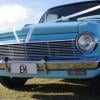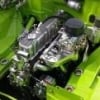my 12 port head had material put in the top of port to turn the air better onto the valve.. mm

The Alloy 9 Port
#51

Posted 30 May 2016 - 03:56 PM
#52

Posted 30 May 2016 - 04:45 PM
Has anyone here played with filling the port opening floor with a bolt in infill to reduce the cross-sectional area and guide airflow so that it flows down to the valve and try to use more of the valve area.
I have tried this on a 12 port and got a small improvement on a port which is a bit on the small side .A 9 port may show more of an improvement.
Yep my 9 port small chamber 161 head has lump ports formed in Z-spar epoxy !!!! Worked a treat !!
#53
 _STRAIGHTLINEMICK_
_STRAIGHTLINEMICK_
Posted 30 May 2016 - 05:41 PM
Yep my 9 port small chamber 161 head has lump ports formed in Z-spar epoxy !!!! Worked a treat !!
Thats what i'm getting at !.
There are NA chev sixes that pull 10's with that type of port ,you can even buy a bolt in cast aluminum lump for 250/292 engines.
Have you had your head flowed ?
#54

Posted 30 May 2016 - 06:07 PM
"They are a great head for NA horsepower with some group nc racers using them to their fullest." WRONG
Just to let you know these heads are NOT legal for Group Nc Historic touring cars.
I would suggest that any Nc guy using these heads is a cheat and should be charged with knowingly entering an illegal car. This is a fairly serious charge under the CAMS regulations and could cost quite a bit of money.
I for one would protest and gladly put up my money if I got wind of any competitor that I was in a race meeting competing against that I suspected of using one of these cylinder heads.
Neither are the recast cast iron heads.
But in saying that they would be legal for improved production category and a better than option than a heavily modified cast iron 9 Port head.
#55

Posted 30 May 2016 - 06:29 PM
Thats what i'm getting at !.
There are NA chev sixes that pull 10's with that type of port ,you can even buy a bolt in cast aluminum lump for 250/292 engines.
Have you had your head flowed ?
Yes Mick over 210 cfm @ 500 thou lift !!! And continued to flow better with higher lift 600-650 thou !! A book by Leo Santucci , Chev inline six cylinder power manual is a great read as you stated The 250/292 chevs have very similar Siamese ported heads !!! The Americans and some very smart Aussies have been doing these mods to heads for decades !!!
Edited by biga064, 30 May 2016 - 06:35 PM.
#56
 _STRAIGHTLINEMICK_
_STRAIGHTLINEMICK_
Posted 30 May 2016 - 07:23 PM
great to see there are some people thinking outside the box. I reckon the lump should be raised until flow is reduced to increase airspeed through the garage port area .This area only needs to be large enough to flow as much as one valve .
#57
 _repco_
_repco_
Posted 30 May 2016 - 07:28 PM
Would that be in the were abouts of 12mm high
#58
 _STRAIGHTLINEMICK_
_STRAIGHTLINEMICK_
Posted 30 May 2016 - 07:30 PM
"They are a great head for NA horsepower with some group nc racers using them to their fullest." WRONG
Just to let you know these heads are NOT legal for Group Nc Historic touring cars.
I would suggest that any Nc guy using these heads is a cheat and should be charged with knowingly entering an illegal car. This is a fairly serious charge under the CAMS regulations and could cost quite a bit of money.
I for one would protest and gladly put up my money if I got wind of any competitor that I was in a race meeting competing against that I suspected of using one of these cylinder heads.
Neither are the recast cast iron heads.
But in saying that they would be legal for improved production category and a better than option than a heavily modified cast iron 9 Port head.
Each to their own but they are no more illegal than the cheater chev castings that were used not so long ago making 202s redundant.i reckon if it looks like a holden head then its good enough for me.
#59
 _STRAIGHTLINEMICK_
_STRAIGHTLINEMICK_
Posted 30 May 2016 - 07:39 PM
Would that be in the were abouts of 12mm high
Just dug out that chev power manual and the lump looks around 10mm high and a flow table shows An improvement in a competition ported head from 217 to 249 cfm for a lump port .A worthwhile improvement.
#60

Posted 30 May 2016 - 07:45 PM
Well there you go
great to see there are some people thinking outside the box. I reckon the lump should be raised until flow is reduced to increase airspeed through the garage port area .This area only needs to be large enough to flow as much as one valve .
Mick the majority of red 9 ports I have seen ported over the years have had there ports increased to big thus dropping airspeed !! Even my manifold has filler added to correct massive over castings ,the results have been impressive !!!
Just dug out that chev power manual and the lump looks around 10mm high and a flow table shows An improvement in a competition ported head from 217 to 249 cfm for a lump port .A worthwhile improvement.
Will help any head to improve even in stock form heads are lazy !!!
#61

Posted 30 May 2016 - 07:50 PM
Great thread here. This is my area of interest, airspeed vs port volume, hence my interest in finding the port volume of a good 9 port garage.
A great video here;
I reckon I could make these. Years ago I trained on CNC milling and if only I could get access to a CNC mill I could draft up the coordinate regime and CAD drawings for them. However, obviously the optimum design needs to be tested and proven first before the design can be digitised.
So anyone have a flow bench handy?
#62
 _STRAIGHTLINEMICK_
_STRAIGHTLINEMICK_
Posted 30 May 2016 - 08:05 PM
#63

Posted 30 May 2016 - 09:18 PM
I think I wanna build a flow bench, fk it....
Only problem is it will be 2019 before I have a spare few hours lol
#64
 _rich243_
_rich243_
Posted 30 May 2016 - 10:02 PM
Yep ive wanted to do the same, have always enjoyed learning how things work rather than just shelling out the $ for someone else.
But i haven't found any decent/cheap flow bench solutions so far for a back yard shed.
#65
 _ljxu1torana_
_ljxu1torana_
Posted 30 May 2016 - 10:53 PM
this is not for a amature to do.
#66

Posted 30 May 2016 - 11:44 PM
No-one starts out as an expert.
Edited by SA EH, 30 May 2016 - 11:46 PM.
#67

Posted 31 May 2016 - 12:21 AM
Has anyone here played with filling the port opening floor with a bolt in infill to reduce the cross-sectional area and guide airflow so that it flows down to the valve and try to use more of the valve area.
I have tried this on a 12 port and got a small improvement on a port which is a bit on the small side .A 9 port may show more of an improvement.
Do you mean something like this?
http://www.12bolt.co...structions.html
Looks like someone beat me to it.
Edited by warrenm, 31 May 2016 - 12:29 AM.
#68
 _ljxu1torana_
_ljxu1torana_
Posted 31 May 2016 - 12:28 AM
hey jonsey can you make one for me.
#69
 _oldjohnno_
_oldjohnno_
Posted 31 May 2016 - 06:17 AM
Don't assume that just because the Holden port looks like a smaller version of the Chev port that it'll behave exactly the same way and respond just as well to a lump. It might not be so.
My first flowbench was an electric leaf blower and a homemade manometer; Vizard calls them "floating depression" I think and I had maybe $80 in it. If you don't need absolute cfm numbers one of these will show you relative gains (or losses) just as well as anything. And they're probably the cheapest and quickest education to air flow you'll ever get. The only problem I had was it was sensitive to changes in line voltage.
My next one had a variable speed blower, digital manometer and a pitot tube. With a set of ASME orifice plates it's easy to calibrate it to give absolute cfm figures and it's accurate and repeatable. Not pretty but less than a grand in it and you can knock one up in a day.
Commercial units are mainly just boxes made pretty - what you're paying for is the fancy stainless cabinet and the sticker. But there's nothing fancy about what's inside, and that's mostly empty space anyway.
A word of warning though - these things are addictive. You'll end up spending hundreds of hours on it and dreaming about turbulence. And they're brutally honest too; before I built my flowbench (and later the dyno) I though I knew a bit about engine building. Nuh, they tell you in no uncertain terms that you're just another dickhead with a lot to learn.
#70

Posted 31 May 2016 - 06:43 AM
Don't assume that just because the Holden port looks like a smaller version of the Chev port that it'll behave exactly the same way and respond just as well to a lump. It might not be so.
My first flowbench was an electric leaf blower and a homemade manometer; Vizard calls them "floating depression" I think and I had maybe $80 in it. If you don't need absolute cfm numbers one of these will show you relative gains (or losses) just as well as anything. And they're probably the cheapest and quickest education to air flow you'll ever get. The only problem I had was it was sensitive to changes in line voltage.
My next one had a variable speed blower, digital manometer and a pitot tube. With a set of ASME orifice plates it's easy to calibrate it to give absolute cfm figures and it's accurate and repeatable. Not pretty but less than a grand in it and you can knock one up in a day.
Commercial units are mainly just boxes made pretty - what you're paying for is the fancy stainless cabinet and the sticker. But there's nothing fancy about what's inside, and that's mostly empty space anyway.
A word of warning though - these things are addictive. You'll end up spending hundreds of hours on it and dreaming about turbulence. And they're brutally honest too; before I built my flowbench (and later the dyno) I though I knew a bit about engine building. Nuh, they tell you in no uncertain terms that you're just another dickhead with a lot to learn.
Love it...
The homemade manometer would work fine for most I reckon... If you started with a known value, say a 190cfm head, you just work from there. Sure you will not know the actual cfm values but you will know whether you have gone forwards or backwards as you have a basline. Plus, when you have reached the highest point, its not hard to have someone with a digital manometer run the head through just once on their bench to determine actual CFM values.
#71
 _STRAIGHTLINEMICK_
_STRAIGHTLINEMICK_
Posted 31 May 2016 - 07:28 AM
#72

Posted 31 May 2016 - 08:51 PM
The thing with the substitute chev blocks heads and the same items for the Mustangs is that they went through a process and were approved. The use of the Alloy cylinder heads is no where near legal as the original was cast iron as we all know. There was never even an option of an Aluminium head for either a holden 6 or the V8s from the factory.
The Irving that was used by PB on the torana that ran at Phillip Island in the mid 1970's was on a sports sedan
#73
 _STRAIGHTLINEMICK_
_STRAIGHTLINEMICK_
Posted 31 May 2016 - 09:14 PM
#74

Posted 31 May 2016 - 09:54 PM
The new cast iron ones are known about and they have also been ruled as not legal. It was put forward to CAMS to allow the use of these heads and after much discussion the proposal to use them was not approved. So we are essentially stuck with the old style 9 port cast heads.
The only thing that has not been put forward is to allow the use of the 12 port cast heads.
If someone was to put that forward then it might get up but until then the use of Aluminium port dividers which are not classified as adding metal is tolerated because they are loose fitting.
The removal of the boss where the head bolt goes down through the port is legal but the replacement with the tube unless it is easily removable could be classified as adding metal a,d could be deemed an illegal modification.
Some people are even going to the extreme of changing the shape of the port by adding epoxy as it is not classified as metal.
#75
 _STRAIGHTLINEMICK_
_STRAIGHTLINEMICK_
Posted 01 June 2016 - 08:47 AM
I dont think a 12 port can be made to flow enough air.
3 user(s) are reading this topic
0 members, 3 guests, 0 anonymous users




 View Garage
View Garage










